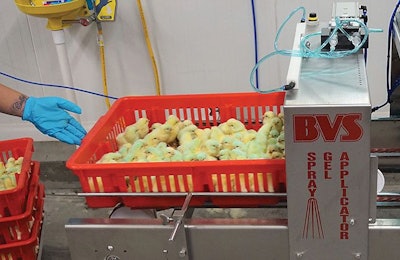
The steady removal of antibiotics from the poultry industry is elevating the importance of using vaccines to prevent common diseases. However, hatcheries must assess how best to apply vaccines to ensure proper inoculation.
Dr. Brian Jordan, an assistant professor of poultry science at the University of Georgia, spoke about the pluses and minuses of both gel and spray vaccine application. He presented as part of a seminar on poultry health and nutrition on March 13 at the 2018 Midwest Poultry Federation Convention in Minneapolis.
The purpose of vaccines
In general, the value of vaccines is elevated as both antibiotics and chemical ionophores are removed from the equation. Jordan said it’s unlikely rules will be rolled back and instead only get tighter, which means vaccines will be critical for developing immunity to disease in longer lived animals like breeders, layers, turkeys and even broilers.
Vaccines work by giving the animals a dose of a live pathogen which, when properly applied, helps them develop a lifelong immunity to the disease. In the hatchery they are typically mass applied as a direct spray or a gel droplet.
The best place to apply a vaccine, he said, is in the hatchery with a direct application to the birds themselves. This way, the vaccine is applied to birds in a chick basket who then preen and groom one another consuming droplets of the spray or gel. A water-based spray is the most common and traditional application method, but in the past four or five years interest in gels is increasing. The goal of both methods is to apply the substance so the birds receive a consistent, effective dose of the vaccine.
Spray versus gel application
Jordan’s remarks centered on coccidia and coccidia vaccination. For coccidia vaccines, the live oocysts are dense and must be properly mixed. Using a water diluent for spray vaccinations requires constant mixing or aeration to prevent settling. Gels keep the oocysts in suspension but, again, they must be initially mixed properly with the vaccine to get proper suspension of the oocysts for even application. The goal of both products is to give an even application so all chicks in the basket receive the proper amount of vaccine.
Jordan said the spray nozzle is critical for water-based sprays. Droplet sizes vary due to the type of nozzle and the level of pressure the fluid is under. Due to the laws of fluid dynamics, both the size and type of the nozzle as well as the pressure of the system need to be adjusted on a case-by-case basis to optimize the application needed for each hatchery and vaccine. Gels, on the other hand, give even, defined droplets with a consistent amount of the oocysts in the droplets.
How much vaccine is actually ingested?
Jordan studied how much of the vaccine is actually getting to the chicks in the products. He saw that with sprays, about half of the oocysts are lost between what’s mixed up in the vaccine bottle and what actually gets down to the level of the chick. Small droplets are also influenced by airflow and may not reach the chicks. Gels provide larger, heavier droplets and provide almost no vaccine loss from the bottle to the chick.
The larger, heavier droplets carry a drawback, however. While recording a slow-motion video, Jordan’s team noticed that the chicks shake after application of either a water-based spray or gel product. The water-based products mat down in the feathers and don’t come off during the shaking. Gels do, which means at least a portion of the droplets go down to the floor of the basket where they are unlikely to be ingested by the chicks.
Which is better?
Jordan said there’s no definitive answer as to one product being significantly better than another. Some vaccines will work better with gel and others will work better with spray. Both methods can be used effectively and both carry their own pros and cons. In his experience, when both products are applied under ideal conditions, no real difference is seen.
Specifically for coccidia, gel vaccination provides a slightly higher ceiling of vaccine coverage if used correctly. With sprays, the ceiling is a bit lower than gels even if application is done perfectly.
However, if there is poor application – or a mistake – then the floor, or the worst possible vaccination outcome, is significantly higher for sprays than gels.
“With spray, your consistency is going to be there a little bit more routinely,” Jordan said.
Nevertheless, the most important factor for proper application in the hatchery is the hatchery personnel itself. If the personnel are not mixing the vaccines and diluents properly, then there will never be consistent application with evenly distributed dosage.
“Some hatcheries have really great employees and have really great hatchery managers who really get buy in from their staff and they do a great job. And then some hatcheries, as hard as they try, there’s a lot of personnel turnover and they have human error that occurs.
"Some hatcheries have fine-tuned operating procedures for vaccine handling and great personnel who do a great job," he said. Others deal with turnover and sometimes human error occurs.
“The quality control, as far as the application system, is only as good as the people that are operating it,” Jordan said.


















